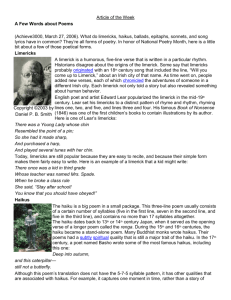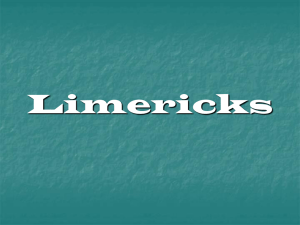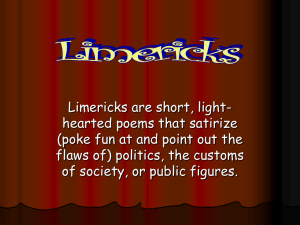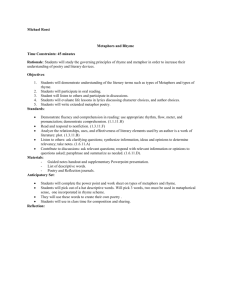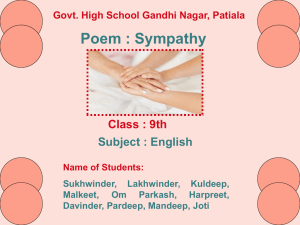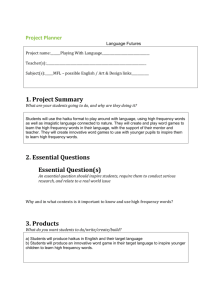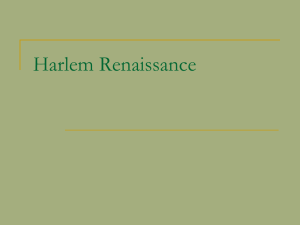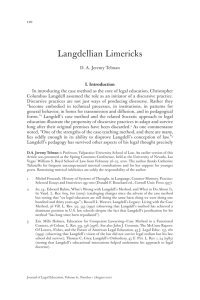Article of the Week A Few Words about Poems (Achieve3000, March
advertisement
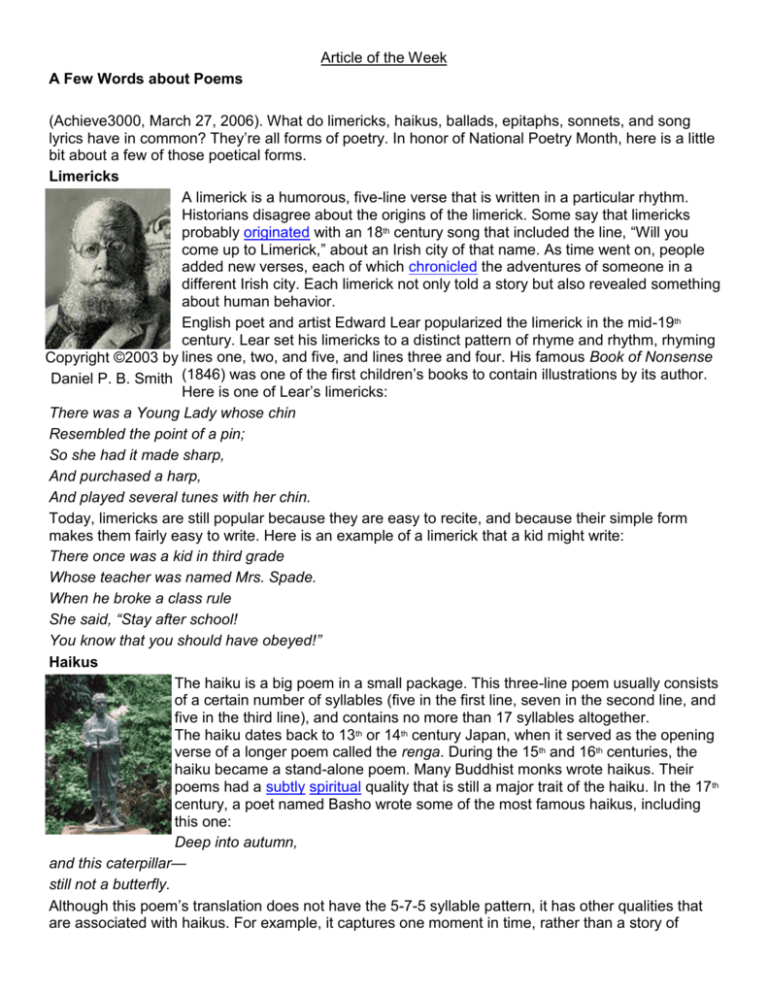
Article of the Week A Few Words about Poems (Achieve3000, March 27, 2006). What do limericks, haikus, ballads, epitaphs, sonnets, and song lyrics have in common? They’re all forms of poetry. In honor of National Poetry Month, here is a little bit about a few of those poetical forms. Limericks A limerick is a humorous, five-line verse that is written in a particular rhythm. Historians disagree about the origins of the limerick. Some say that limericks probably originated with an 18th century song that included the line, “Will you come up to Limerick,” about an Irish city of that name. As time went on, people added new verses, each of which chronicled the adventures of someone in a different Irish city. Each limerick not only told a story but also revealed something about human behavior. English poet and artist Edward Lear popularized the limerick in the mid-19th century. Lear set his limericks to a distinct pattern of rhyme and rhythm, rhyming Copyright ©2003 by lines one, two, and five, and lines three and four. His famous Book of Nonsense Daniel P. B. Smith (1846) was one of the first children’s books to contain illustrations by its author. Here is one of Lear’s limericks: There was a Young Lady whose chin Resembled the point of a pin; So she had it made sharp, And purchased a harp, And played several tunes with her chin. Today, limericks are still popular because they are easy to recite, and because their simple form makes them fairly easy to write. Here is an example of a limerick that a kid might write: There once was a kid in third grade Whose teacher was named Mrs. Spade. When he broke a class rule She said, “Stay after school! You know that you should have obeyed!” Haikus The haiku is a big poem in a small package. This three-line poem usually consists of a certain number of syllables (five in the first line, seven in the second line, and five in the third line), and contains no more than 17 syllables altogether. The haiku dates back to 13th or 14th century Japan, when it served as the opening verse of a longer poem called the renga. During the 15th and 16th centuries, the haiku became a stand-alone poem. Many Buddhist monks wrote haikus. Their poems had a subtly spiritual quality that is still a major trait of the haiku. In the 17th century, a poet named Basho wrote some of the most famous haikus, including this one: Deep into autumn, and this caterpillar— still not a butterfly. Although this poem’s translation does not have the 5-7-5 syllable pattern, it has other qualities that are associated with haikus. For example, it captures one moment in time, rather than a story of many years. In the typical haiku, the first line describes the image, and the second line expands on it. The third line is usually an observation about the image. Haikus rarely have a clear meaning. Instead, they set the scene in very few words and leave the interpretation up to the reader. Ballads A ballad is a narrative poem, which means that it tells a story. Ballads are written in the common language of the culture where they originate. For example, a ballad from the U.S. is written in a style of English that most people can clearly understand. There are a few differences between ballads and stories. First, ballads mostly contain action and dialogue, but very little description. In addition, ballads rhyme and are set to a rhythm, and although ballads can be recited, many of them are put to music and sung. Here are two stanzas from a ballad called “Paul Revere’s Ride,” written by Henry Wadsworth Longfellow in the 19th century: Library of Congress Listen my children and you shall hear Of the midnight ride of Paul Revere, On the eighteenth of April, in Seventy-five; Hardly a man is now alive Who remembers that famous day and year. He said to his friend, “If the British march By land or sea from the town to-night, Hang a lantern aloft in the belfry arch Of the North Church tower as a signal light,— One if by land, and two if by sea; And I on the opposite shore will be, Ready to ride and spread the alarm Through every Middlesex village and farm, For the country folk to be up and to arm.” Who’s a Poet? You don’t have to take classes or get a special degree to be a poet. Anyone can write poems, because poems are simply forms of expression. Some poems, such as limericks, haikus, and ballads, follow rules, while others are less formal. Any kind of verse can be called a poem, whether it is a nursery rhyme, a brief description, or a song lyric. Poets have many different backgrounds and experiences, and that is what makes poetry so interesting. It’s hard to pinpoint a poet—your grocer or your garbage collector could be a poet. In fact, many published poets have other jobs, because they find that their writing just doesn’t pay the bills. Basho, for example, began his adult life as a samurai. And when Edward Lear wasn’t writing “nonsense” poems, such as limericks, he drew examples of birds for the London Zoological Society. Here is a list of some poets and their day jobs: Marianne Moore: Public library clerk Robert Frost: Poultry farmer William Carlos Williams: Pediatrician T.S. Eliot: Banker William Bronk: Fuel oil salesman Barbara Harr: Taxicab driver Maybe someone you know is a poet, too! Article of the Week Four-Square Activity Instructions: After reading the article of the week, you will have fifteen minutes to create one level-one question, two level-two questions, and one level-three question for the article. Then, you will need to choose one of either your level two or level three questions and answer this in the form of a point. After the fifteen minutes have expired, you will follow these steps: 1. Pass your four-square activity to the person behind you. The person in the back of the column will pass it to the person in the front of the column. 2. Write this new point on the outline (on the back) and then find evidence to support this point. 3. At that point, follow step one again. 4. Next, create an evidence link for the outline that you just received. 5. Follow step one again. 6. Now, write some commentary for the paper you just received. This should complete the outline. 7. Finally, pass the paper back to the original owner. 8. Whenever you receive your paper, read the outline, edit and revise it as needed, and then (on a separate sheet of paper) turn the outline into a PEEC paragraph. Level-One Question: Level-Two Question: Point: ______________________________________________________________________________________ Level-Two Question: Level-Three Question: PEEC Outline Instructions: Take the point from the four-square activity and outline a PEEC paragraph. I. Point (your claim that answers the question) _________________________________________________________________________________________ __________________________________________________________________________________________ II. Evidence Link: (background information concerning what is going on in the reading passage) __________________________________________________________________________________________ __________________________________________________________________________________________ __________________________________________________________________________________________ __________________________________________________________________________________________ III. Evidence with Documentation (something quoted from the passages that supports your point) __________________________________________________________________________________________ __________________________________________________________________________________________ __________________________________________________________________________________________ __________________________________________________________________________________________ IV. Commentary (explanation for how your evidence supports your point) __________________________________________________________________________________________ __________________________________________________________________________________________ __________________________________________________________________________________________ __________________________________________________________________________________________ __________________________________________________________________________________________ __________________________________________________________________________________________
